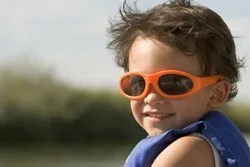Thoughts of summer with the kids probably center on days outside at the pool or beach — not your children’s eyes. But summertime activities can greatly affect vision and the eyes, so consider these seasonal tips.

The dangers of the sun’s rays
The sun emits two types of ultraviolet (UV) radiation, UV-A and UV-B, both of which are harmful to the eyes. UV rays have been linked to cataracts, macular degeneration and other eye conditions that can compromise vision. Cataracts and age-related macular degeneration (AMD) are the major causes of poor vision and blindness in the aging U.S. population.
Unfortunately, the effects of UV rays are cumulative. Research shows that by age 18, most people have accrued 80 percent of their total lifetime exposure to the sun. What’s more, children’s eyes continue to develop as they grow, and are more susceptible to UV radiation during their first 18 years. So, the protective lenses you choose for your children today can help determine how well they’ll see in the future.
Beware reflective surfaces
Don’t forget that UV rays can be reflected from surfaces such as water, white sand and concrete (and snow in the winter). Reflected rays can cause sunburn and eye damage.
Eye burns and other dangers
Overexposure to UV light (such as a day at the beach without eye protection) can cause a temporary, painful burn to the surface of the eye (cornea), similar to sunburn on the skin. Staring directly at the sun can permanently scar the retina, the area at the back of the eye responsible for vision. And repeated over-exposure to UV rays can cause cancer of the eyelids and surrounding skin.
The importance of sunglasses
UV-absorbing eyewear provides the greatest measure of protection from the sun, particularly if it has a wraparound design to limit the entry of peripheral rays. Many sunglasses indicate if they absorb UV-A and UV-B rays. The darkness of the tint in the glasses has no correlation to the UV protection the glasses offer. A wide-brimmed hat or cap blocks roughly only 50 percent of UV radiation. So the next time you put sunscreen on your kids, make sure they also put on glasses that have full UV-A and UV-B ray protection.
MICHAL LUCHINS, O.D., runs the Family Vision & Learning Center, a full-service optometry practice for the entire family located in Suffern. Dr. Luchins specializes in vision therapy and developmental optometry. She is also certified in both early childhood education and processing and cognitive enhancement. For more info: 845-369-3235; www.optometrists.org/DrLuchins.





















